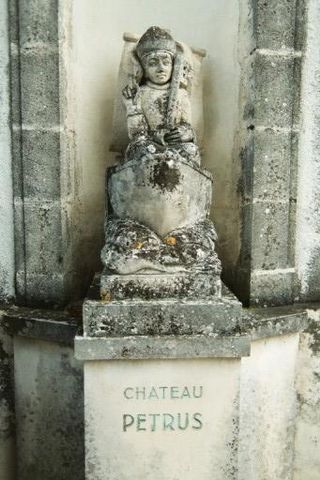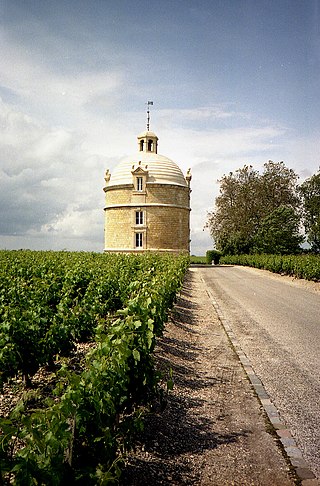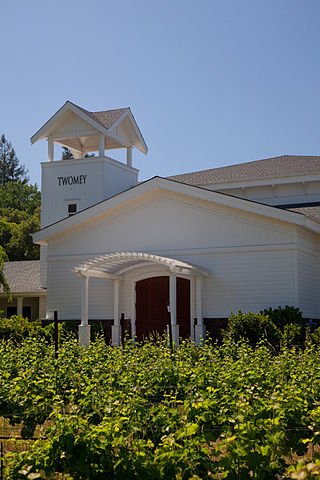
Pétrus is a Bordeaux, France, wine estate located in the Pomerol appellation near its eastern border to Saint-Émilion. A small estate of just 11.4 hectares, it produces a red wine entirely from Merlot grapes, and produces no second wine. The estate belongs to Jean-François Moueix and his children.

The Bordeaux Wine Official Classification of 1855 resulted from the 1855 Exposition Universelle de Paris, when Emperor Napoleon III requested a classification system for France's best Bordeaux wines that were to be on display for visitors from around the world. Brokers from the wine industry ranked the wines according to a château's reputation and trading price, which at that time was directly related to quality.

Château Lafite Rothschild is a French wine estate of Bordeaux wine, located in Pauillac in France, owned by members of the Rothschild family since the 19th century, and rated as a First Growth under the 1855 Bordeaux Classification.

Château Latour is a French wine estate, rated as a First Growth under the 1855 Bordeaux Classification. Latour lies at the very southeastern tip of the commune of Pauillac in the Médoc region to the north-west of Bordeaux, at its border with Saint-Julien, and only a few hundred metres from the banks of the Gironde estuary.
Wine accessories are things that may be used in the storage or serving of wine. Wine accessories include many items such as wine glasses, corkscrews, and wine racks.

Bordeaux wine is produced in the Bordeaux region of southwest France, around the city of Bordeaux, on the Garonne River. To the north of the city the Dordogne River joins the Garonne forming the broad estuary called the Gironde; the Gironde department, with a total vineyard area of 110,800 hectares, is the largest wine growing area in France.
Alexis Lichine was a Russian wine writer and entrepreneur. He played a key role in promoting varietal labelling of wine, was a masterful salesman of wine, and owned Château Prieuré-Lichine and a share of Château Lascombes in the Médoc. He was married to actress Arlene Dahl from 1964 to 1969.
Château Lascombes is a winery in the Margaux appellation of the Bordeaux region of France. The wine produced here was classified as one of fifteen Seconds Crus in the original Bordeaux Wine Official Classification of 1855. In the 1950s, the estate was purchased by French wine writer Alexis Lichine who continued to own part of the estate till 1971 when Bass Charrington took over principal ownership. In 2001 it was purchased by Yves Vatelot and US-based Colony Capital, who in 2011 sold it to the French insurance group MACSF. In addition to its premier cuvee, a second wine is also produced, under the name Chevalier de Lascombes. Additional brands are Château Segonnes, Rosé de Lascombes, Vin Sec Chevalier de Lascombes and Gombaud.
The glossary of wine terms lists the definitions of many general terms used within the wine industry. For terms specific to viticulture, winemaking, grape varieties, and wine tasting, see the topic specific list in the "See also" section below.

A wine cellar is a storage room for wine in bottles or barrels, or more rarely in carboys, amphorae, or plastic containers. In an active wine cellar, important factors such as temperature and humidity are maintained by a climate control system. In contrast, passive wine cellars are not climate-controlled, and are usually built underground to reduce temperature swings. An aboveground wine cellar is often called a wine room, while a small wine cellar is sometimes termed a wine closet. The household department responsible for the storage, care and service of wine in a great mediaeval house was termed the buttery. Large wine cellars date back over 3,700 years.

Château Cantemerle is a winery in the Haut-Médoc appellation of the Bordeaux wine region of France, in the commune of Macau. The wine produced here was the final estate to be classified as one of eighteen Cinquièmes Crus in the Bordeaux Wine Official Classification of 1855. Its absence from the classification map featured at the 1855 Exposition Universelle de Paris created some controversy, even though it has been listed on all maps published after 1855. Some sources will include an asterisk next to Château Cantemerle listing in reference to this controversy. The estate has a long history in the Haut-Médoc with records detailing its existence since at least the 12th century and wine production since at least the 14th century. In the 19th century, the estate was hard hit by the phylloxera epidemic as well as grapevine attacks of downy mildew, after which production dropped nearly 50%. Towards the end of the 20th century, the estate was sold to French insurance group Les Mutuelles d'Assurance du Bâtiment et des Travaux Public who have contributed significant investment in the estate's vineyards and winemaking facilities.
Château Desmirail is a winery in the Margaux appellation of the Bordeaux wine region of France. It was classified as one of fourteen Troisièmes Crus in the historic Bordeaux Wine Official Classification of 1855.
Château Calon-Ségur is a winery in the Saint-Estèphe appellation of the Bordeaux wine region of France. The wine produced here was classified as one of fourteen Troisièmes Crus Classés in the historic Bordeaux Wine Official Classification of 1855. It is the northernmost classified growth in the Médoc.

Château la Mission Haut-Brion is a Bordeaux wine from the Pessac-Léognan appellation, classed among the Crus Classés in the Graves classification of 1953. La Mission Haut-Brion is the sister property of the First Growth Château Haut-Brion. The winery, located in close vicinity of the city of Bordeaux, belongs to the wine region Graves, in the commune of Talence with additional property in Pessac.
Château Rieussec is a sweet white wine ranked as Premier Cru Classé in the original Bordeaux Wine Official Classification of 1855. Belonging to the Sauternes appellation in Gironde, in the region of Graves, the winery is located in the commune of Fargues.
Médoc is an AOC for wine in the Bordeaux wine region of southwestern France, on the Left Bank of the Gironde estuary that covers the northern section of the viticultural strip along the Médoc peninsula. The zone is sometimes called Bas-Médoc, though this term is not permitted on any label. With few exceptions there is produced only red wine, and no white wine has the right to be called Médoc.

The role of yeast in winemaking is the most important element that distinguishes wine from fruit juice. In the absence of oxygen, yeast converts the sugars of the fruit into alcohol and carbon dioxide through the process of fermentation. The more sugars in the grapes, the higher the potential alcohol level of the wine if the yeast are allowed to carry out fermentation to dryness. Sometimes winemakers will stop fermentation early in order to leave some residual sugars and sweetness in the wine such as with dessert wines. This can be achieved by dropping fermentation temperatures to the point where the yeast are inactive, sterile filtering the wine to remove the yeast or fortification with brandy or neutral spirits to kill off the yeast cells. If fermentation is unintentionally stopped, such as when the yeasts become exhausted of available nutrients and the wine has not yet reached dryness, this is considered a stuck fermentation.
Winemaking in Bordeaux is the collection of processes used to make Bordeaux wine. Winemaking in Bordeaux differs from winemaking in other places both because of the Bordelais climate and because of the particular Bordeaux style which the wine-maker is aiming for. A large number of processes are involved: pruning, training, spraying,, harvesting, (sorting), (de-stemming), crushing, fermentation, pressing, barrel-ageing, blending, bottling and bottle-ageing.

Twomey Cellars is a California winery. It was established in 1999 by the Duncan Family, who have operated the successful Silver Oak Cellars in California since 1972. The Duncan Family started Twomey Cellars to pursue varietals other than Cabernet Sauvignon. Twomey has three wineries: one in Calistoga in the Napa Valley; one in Healdsburg in the Russian River Valley; one in Philo in Anderson Valley, and produces mainly Pinot noir and Sauvignon blanc. Twomey’s Sauvignon blanc is a blend of Sauvignon blanc grapes from their estate vineyards at their wineries in Napa Valley, Anderson Valley, and Russian River Valley.

Daniel Baron is an American winemaker. He is best known for his work with the Duncan family-owned Silver Oak Cellars and Twomey Cellars, and was Director of Winemaking for both. After his retirement in 2017, he launched Complant Wine with his son, Sam Baron, to produce small production, artisanal, single vineyard wines. Originally a field worker for John Rolleri at Chateau Montelena, he gained experience in the Bordeaux region of France and was mentored by the likes of grape geneticist Professor Harold Olmo, and winemakers Jean-Claude Berrouet and Justin Meyer. He became general manager of Christian Moueix's Dominus Estate in the 1980s. He became winemaker for Silver Oak, an exclusive Cabernet Sauvignon producer, in 1994, and was trained by Justin Meyer to follow in his footsteps as Silver Oak's winemaker before Meyer’s retirement in 2001. In 1999, Baron was instrumental in persuading the Duncans to establish Twomey to pursue Merlot, Pinot noir, and Sauvignon blanc after discovering high quality Merlot grapes on Silver Oak’s Soda Canyon Ranch Vineyard. He has served on boards such as the American Society of Enology and Viticulture and the Napa Valley Wine Technical Group.













